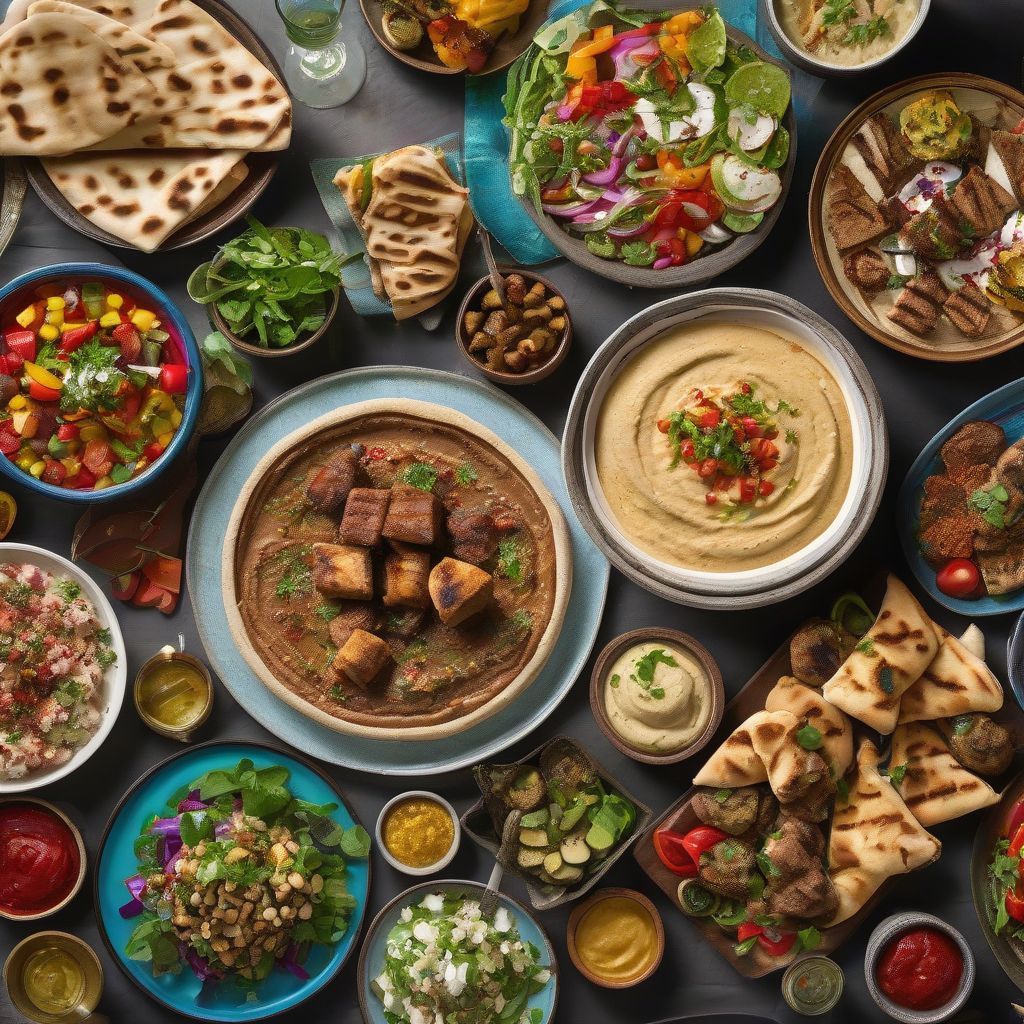Imagine biting into a warm, fluffy pita bread overflowing with flavorful falafel, creamy hummus, and tangy pickles. Or perhaps a table laden with fragrant saffron rice, juicy grilled meats, and an array of colorful dips and salads tantalizes your senses. This, my friends, is the allure of Middle Eastern cuisine, a culinary tradition that has been captivating taste buds and influencing global food trends for years.
As a nutritionist and meal-planning coach passionate about healthy eating, I’ve witnessed firsthand the growing fascination with Middle Eastern food. It’s no longer a niche cuisine confined to specific regions. It’s a global phenomenon, embraced for its vibrant flavors, fresh ingredients, and health benefits. But what exactly is driving this culinary movement?
Unpacking the Essence of Middle Eastern Cuisine
Before we delve into its global impact, let’s understand what defines this vibrant culinary tradition. Middle Eastern cuisine encompasses a diverse range of flavors and ingredients from countries like Lebanon, Syria, Iran, Israel, Egypt, and beyond. While each country boasts unique dishes and culinary approaches, certain common threads tie them together:
-
Fresh, Vibrant Ingredients: Think sun-ripened vegetables like tomatoes, cucumbers, and eggplant, alongside fresh herbs like mint, parsley, and cilantro. These vibrant components add a burst of freshness and color to every dish.
-
Aromatic Spices: Middle Eastern cuisine is a symphony of spices. Cumin, coriander, turmeric, sumac, and za’atar are just a few examples that lend warmth, depth, and complexity to the food.
-
Emphasis on Plant-Based Foods: Pulses like chickpeas and lentils, vegetables, and grains like bulgur and freekeh form the foundation of many dishes, aligning with the rising global interest in plant-based diets.
-
Creative Use of Herbs & Yogurt: Fresh herbs not only elevate flavors but also offer numerous health benefits. Similarly, yogurt, in its various forms, adds a creamy texture and tangy twist to both savory and sweet dishes.
 A Vibrant Spread of Middle Eastern Cuisine
A Vibrant Spread of Middle Eastern Cuisine
The Middle Eastern Influence: Transforming Global Food Trends
Now, let’s explore how this vibrant cuisine is making its mark on the global culinary landscape:
1. The Rise of Plant-Forward Eating
With a focus on plant-based ingredients, Middle Eastern cuisine aligns perfectly with the growing global trend of reducing meat consumption. Dishes like falafel, hummus, and lentil soup have become mainstream favorites, embraced by vegans, vegetarians, and meat-eaters alike. This culinary shift is driven by health concerns, environmental awareness, and ethical considerations, making Middle Eastern cuisine a delicious and accessible entry point for those exploring plant-forward eating.
2. A Celebration of Flavor and Freshness
In a world saturated with processed foods, there’s a renewed appreciation for fresh, flavorful ingredients, a hallmark of Middle Eastern cooking. The emphasis on vibrant salads, grilled meats, and dishes bursting with herbs and spices offers a welcome departure from bland, monotonous meals. This focus on fresh, wholesome ingredients aligns perfectly with the growing consumer desire for healthier, more flavorful food choices.
3. The Allure of Shared Plates and Social Dining
Food in the Middle East is more than just sustenance; it’s a celebration of community and connection. The concept of shared plates, like mezze, encourages a communal dining experience, fostering conversation and togetherness. This social aspect of dining has resonated with diners worldwide, as people seek to recreate the warmth and connection of shared meals.
4. The Health Halo Effect
Many perceive Middle Eastern cuisine as inherently healthy due to its emphasis on vegetables, lean proteins, and whole grains. While it’s essential to remember that moderation and balanced choices are key to any healthy diet, the abundance of fresh, minimally processed ingredients contributes to the perception of this cuisine as a nutritious option.
5. The Influence on Restaurant Menus and Food Trucks
Walk into any major city today, and you’ll likely find an array of Middle Eastern restaurants and food stalls. From upscale dining experiences to casual eateries and street food vendors, this cuisine has permeated all facets of the culinary landscape. The availability and accessibility of these diverse dining options have further fueled the global fascination with Middle Eastern flavors.
[amazon bestseller=”Middle Eastern Cuisine”]
Beyond the Plate: The Cultural Impact
The influence of Middle Eastern cuisine extends far beyond just our plates. It’s sparked a global curiosity about the region’s culture, traditions, and hospitality. People are eager to recreate the warm, inviting atmosphere of Middle Eastern dining in their homes, experimenting with new spices, and seeking out authentic ingredients. This cultural exchange through food fosters understanding, appreciation, and a sense of global interconnectedness.
Conclusion: A Culinary Journey Worth Savoring
The irresistible rise of Middle Eastern cuisine is a testament to its ability to transcend borders and captivate palates worldwide. As we become increasingly conscious of our food choices and seek out flavorful, healthy, and sustainable options, this vibrant culinary tradition is poised to remain a dominant force in global food trends. So, embrace the flavors of the Middle East, experiment with new recipes, and embark on a culinary journey that promises to tantalize your taste buds and broaden your culinary horizons.
What are your favorite Middle Eastern dishes or ingredients? Share your thoughts and culinary adventures in the comments below!
